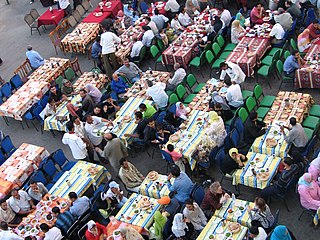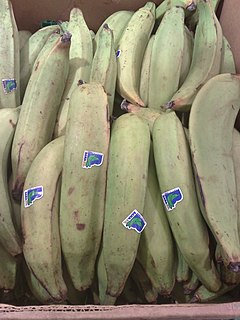
Cooking bananas are banana cultivars in the genus Musa whose fruits are generally used in cooking. They may be eaten ripe or unripe and are generally starchy. Many cooking bananas are referred to as plantains or green bananas, although not all of them are true plantains. Bananas are treated as a starchy fruit with a relatively neutral flavour and soft texture when cooked. Bananas fruit all year round, making them a reliable all-season staple food.
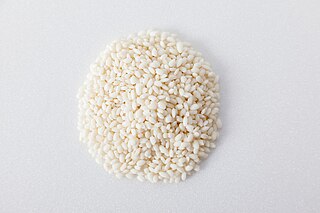
Glutinous rice is a type of rice grown mainly in Southeast and East Asia and the eastern parts of South Asia, which has opaque grains, very low amylose content, and is especially sticky when cooked. It is widely consumed across Asia.

Puerto Rican cuisine has its roots in the cooking traditions and practices of Europe, Africa and the native Taínos. Starting from the latter part of the 19th century. Puerto Rican cuisine can be found in several other countries.

Hallaca is a Venezuelan dish. It consists of corn dough stuffed with a stew of beef, pork, or chicken and other ingredients such as raisins, capers, and olives Like some tamales, hallacas are folded in plantain leaves, tied with strings, and boiled; The dish is traditionally served during the Christmas season and has several regional variants in Venezuela. It has been described as a national dish of Venezuela. A characteristic of the hallaca is the delicate corn dough made with consommé or broth and lard colored with annatto. Hallacas are also commonly consumed in eastern Cuba parts of Colombia, and Ecuador.

Puran poli is an Indian sweet flatbread.
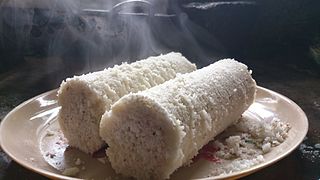
Puttu, or pittu, is a breakfast dish originating from the Indian state of Kerala, eaten in Kerala, Tamil Nadu, parts of Karnataka, and Sri Lanka. Puttu means "portioned" in Malayalam. It is made of steamed cylinders of ground rice layered with coconut, often with a sweet or savory filling on the inside. It is highly popular in the Indian state of Kerala as well as in many areas of Sri Lanka, where it is also known as pittu. Puttu is served with side dishes such as palm sugar or chickpea curry or banana. In Bhatkal Puttu is served with side dishes such as ghee and sugar or Paya.

Colombian cuisine is a compound of the culinary traditions of the six main regions within the country. Colombian cuisine varies regionally and is particularly influenced by Indigenous Colombian, Spanish, and African cuisines, with slight Arab influence in some regions. Furthermore, being one of the most biodiverse countries in the world, Colombia has one of the widest variety of available ingredients depending on the region.
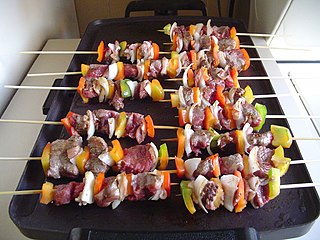
Honduran cuisine is a fusion of indigenous (Lenca), Spanish, Caribbean and African cuisines. There are also dishes from the Garifuna people. Coconut and coconut milk are featured in both sweet and savory dishes. Regional specialties include fried fish, tamales, carne asada and baleadas. Other popular dishes include meat roasted with chismol and carne asada, chicken with rice and corn, and fried fish with pickled onions and jalapeños. In the coastal areas and the Bay Islands, seafood and some meats are prepared in many ways, including with coconut milk.
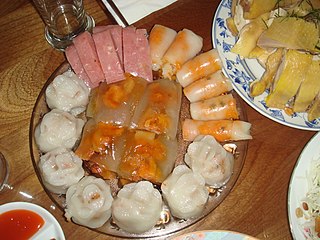
In Vietnamese, the term bánh translates loosely as "cake" or "bread", referring to a wide variety of prepared foods. With the addition of qualifying adjectives, bánh refers to a wide variety of sweet or savoury, distinct cakes, buns, pastries, sandwiches, and other food items, which may be cooked by steaming, baking, frying, deep-frying, or boiling. Foods made from wheat flour are generally called bánh, but the term may also refer to certain varieties of noodle and fish cake dishes, such as bánh canh and bánh hỏi.

Most traditional foods in Guatemalan cuisine are based on Maya cuisine and prominently feature corn, chilies and beans as key ingredients.

Kuswar is a term often used to mention a set of unique Christmas goodies which are part of the cuisine of the Goan Catholic community of Goa and the Mangalorean Catholic community of Karnataka, India. There are as many as 22 different traditional recipes that form this distinct flavour of Christmas celebration in Goa and Mangalore. Kuswar originally hails from Goa, India.

Chatti pathiri is a layered pastry made in the North Malabar and Malabar region, of Kerala, India. It is made in both sweet and savoury variations. The dish is similar to the Italian lasagna, but instead of pasta, pastry sheets / pancakes made with flour, egg, oil and water are used. The filling depends on the variation desired. The sweet ones are made with sweetened beaten eggs, nuts and raisins, seasoned with cardamom. The savoury ones are made with traditional meat filling used in making samosas or savoury puffs. The flour is kneaded into soft dough and rolled into thin pancakes. These pancakes are soaked in milk to soften them and arranged in layers. The fillings are added between these layers. Once layered, it goes in for baking at 180 degrees for approximately 20 minutes.

Ada or Ela Ada, is an Indian sweet and traditional Kerala delicacy, consisting of rice parcels encased in a dough made of rice flour, with sweet fillings, steamed in banana leaf and served as an evening snack or as part of breakfast. It can be seen even in parts of Tamil Nadu as well. Grated coconut and rice flour are the two main ingredients. It is a snack made out of raw rice flour, sugar or jaggery and grated coconut. It is usually prepared on Onam. Poovada is prepared in the tip end of the plantain leaf as the Nivedyam for Onam, into this ada goes, with the coconut filling, a sprinkling of the Thumbapoo, making it more auspicious. Sometimes banana is also added in the filing which is coconut-jaggery-banana filling. Spicy Ottada is a unique breakfast with maida and rice flour as the main ingredients. It can be also made without maida, but using the rice flour alone and it is not steamed instead cooked on Tava or flame. Sometimes the fillings inside ada would be Chakkavaratti. Ada is also given as Prasadam to devotees at temples in Kerala.
A great variety of cassava-based dishes are consumed in the regions where cassava is cultivated, and they include many national or ethnic specialities.
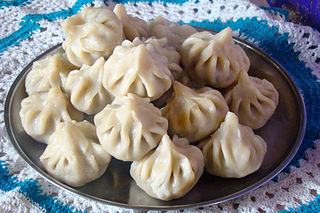
Modak is an Indian sweet popular in many parts of India. The sweet filling on the inside of a modak consists of freshly grated coconut and jaggery while the outer soft shell is made from rice flour or wheat flour mixed with khava or maida flour.
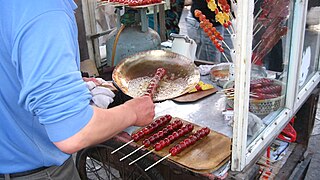
Street foods, ready-to-eat food or drink sold in a street or other public place, such as a market or fair, by a hawker or vendor, often from a portable stall, have variations within both regions and cultures. For example, Dorling Kindersley describes the street food of Viet Nam as being "fresh and lighter than many of the cuisines in the area" and "draw[ing] heavily on herbs, chile peppers and lime," while street food of Thailand is "fiery" and "pungent with shrimp paste... and fish sauce" with New York City's signature street food being the hot dog, although the offerings in New York also range from "spicy Middle Eastern falafel or Jamaican jerk chicken to Belgian waffles." In Hawaii, the local street food tradition of "Plate Lunch" was inspired by the bento of the Japanese who had been brought to Hawaii as plantation workers.

Dumpling is a broad classification for a dish that consists of pieces of dough wrapped around a filling or of dough with no filling. The dough can be based on bread, flour, or potatoes, and may be filled with meat, fish, cheese, vegetables, fruits, or sweets. Dumplings may be prepared using a variety of methods, including baking, boiling, frying, simmering, or steaming, and are found in many world cuisines.

A paratha is a flatbread that originated in the Indian subcontinent, prevalent throughout areas of India, Sri Lanka, Pakistan, Nepal and Bangladesh where wheat is the traditional staple. Paratha is an amalgamation of the words parat and atta, which literally means layers of cooked dough. Alternative spellings and names include parantha, parauntha, prontha, parontay, porota, palata, porotha, forota and farata.

